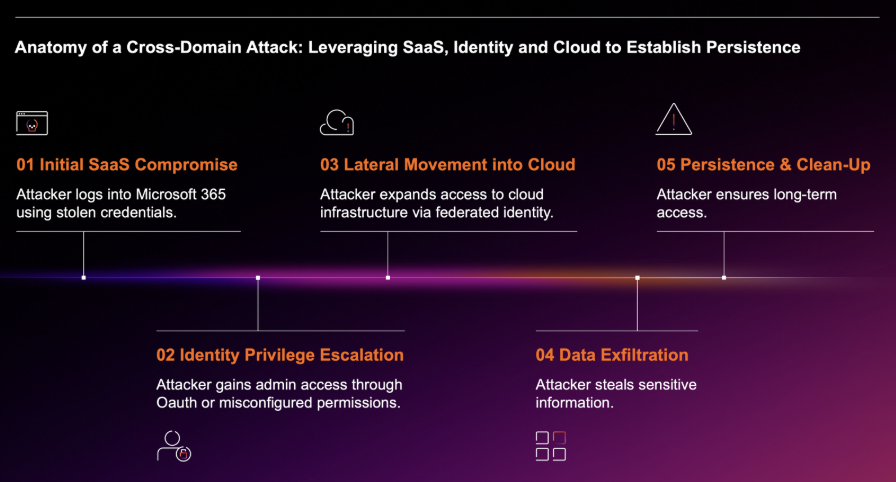What are the people, process, and technology assets that would do the most harm, if compromised by an attacker?
Attack path modeling provides a detailed map of all the roads that lead to an organization's crown jewels, prioritized in order of likelihood and potential impact. CISO's are increasingly looking to this kind of solution to complement their security stack because it highlights risks that are specific to this organization's structure, as well as potentially unexpected relationships between devices or users that would prove catastrophic if they were exploited.
What makes Darktrace's Attack Path Modeling solution stand out?
- Data sources are varied and information from the entire digital estate is considered
- Modeling is real-time and continuously re-evaluated
- Output does not require expert technical knowledge to be leveraged
- Valuable as a standalone for vulnerability prioritization
- As a component of the Darktrace ActiveAI Security Platform, the solution provides immediate value by feeding back into detection and response engines (e.g. tag critical assets for detection) but also provides long term systemic improvements as outcomes are followed up.
Thinking like an attacker
It is anticipated that CISOs will soon move beyond just insurance and checkbox compliance, as underwriters include more and more exclusions for certain types of cyber-attacks and the limits of compliance ticking the protection box rather than bolstering operational assurance become more apparent. They will push their teams to opt for more proactive cyber security measures to maximize ROI in the face of budget cuts, shifting investment into tools and capabilities that continuously improve their cyber resilience and demonstrate cyber risk reduction.
While red teams can provide insight into where effort and resource should be most immediately applied, the exercises themselves are often costly, non-exhaustive and infrequently run.
Hackers are constantly seeking pathways, preferably those of least resistance, to compromise a system by exploiting its vulnerabilities. Attack path modeling enables security teams to look at their environment from the perspective of the attacker. In turn, this helps them eliminate attack paths progressively, reducing the options an attacker would have, should they breach the walls.
A deeper dive into Attack Path Modeling
An attack path is a visual representation of the path that an attacker takes to exploit a weakness in the system. It highlights the series of steps (attack vectors) that a threat actor might take from one of the doors into the organization (attack surface) to access valuable assets.
It is typically unusual for an attacker to have a boulevard straight down to the crown jewels. They will most likely leverage a couple of loopholes, unexpected relationships and blind spots in the security stack to piece together a path to these confidential assets. Attack path modeling can help to highlight the attack vectors that connect, to form this path to compromise.


How to model attack paths
Darktrace's proprietary Self-Learning AI models relationships, and graph theory is incorporated to understand the importance of users, documents and relationships between these.
Darktrace's Attack Path Modeling component identifies target nodes (users, accounts, devices), it then calculates the shortest paths to these target nodes and weights the results according to the likelihood of this attack path and the damage caused if the target asset was compromised. This is exactly what an attacker would do when planning an attack, albeit with a significant advantage to Darktrace's AI Engine, which has access to more information than the attacker. For the first time, defenders have the upper hand against attackers.
Avoiding siloed efforts
According to a Gartner survey, 75% of organizations are looking at consolidating security tools, not primarily because of cost, but because it helps drive cyber risk reduction. Ensuring that security efforts are part of a wider security ecosystem, rather than siloed efforts, is crucial to maximize the return on these investments.
Darktrace / Proactive Exposure Management integrates with Darktrace's detection and response to ensure that the organization's security posture is hardened, even if the team doesn't have time to eliminate the attack path.
Defensive superiority is key, and Attack Path Modeling is one way to help security teams gain back an advantage. Find out how you can test it in your own environment.
Attack Path Modeling is an objective, however, and there are a few important questions to consider when assessing the different methods of creating these models.
Are we considering all the relevant data when building my attack paths map?
Consider the case where one of your marketing executives has a close friendship with someone in your development team. How do you model that into your attack paths cartography? Attack paths encompass the full digital estate, so the attack path modeling solution should consider information from various parts, internal and external. This may include data from the Email environment, the Network, Endpoints, SaaS & Cloud, Active Directory, Vulnerability Scanners, etc.
Cross-data analysis is the only way to understand holistic attack paths.
Are we looking at the most up to date map of attack paths?
Relationships between users, devices and other sensitive assets can evolve on a daily basis, this implies attack paths evolve on a daily basis. Ensuring that the methods or solutions used update their understanding continuously and in real-time is vital if security teams want the most up to date understanding of their organization's risk posture.
To improve our security posture, how do we know which attack paths to start with?
One thing is to map the sum-total of attack paths, another is to prioritize them. Attack path modeling gives you the map but adding a risk-assessment (explored in more depth below) layer on top is how you prioritize. This is where graph theory can be very useful to identify choke points that you may want to strengthen.
Does this output yield actionable insights?
The prime objective of this solution is not simply to provide an assessment of cyber risk posture, but rather to help drive security efforts in the right direction. To that end, the output needs to be accessible to team members that may not have expert cyber skills. Lowering barriers to entry with usable insights and mitigation advice is key to successfully improve the organization's security posture.
Assessing risk to prioritize attack paths
Darktrace Attack Path Modeling (APM) is a risk-based approach to assessing cyber-attack pathways, thinking like an attacker, and probing the path of least resistance. 'Risk' in this case is defined as the product of two factors: Probability and Impact. By using this information to categorize possible attack paths in the risk matrix below, Darktrace's APM can prioritize attack paths to ensure security team efforts are spent on controlling for the most relevant risks for their organization.

A: Defining Probability
There are two types of probability to consider:
The likelihood of one particular door being chosen by an attacker to infiltrate the organization (among the assets at the attack surface - this could be an internet-facing server, an inbox, a SaaS/Cloud account, etc). And,
The likelihood of one particular node (defined as a device or user account) being compromised next, via lateral movement.

B: Defining Impact
Impact refers to the overall impact of an asset being compromised and unusable. In the case of an asset (e.g.: a key server), the bigger the disruption if this asset goes down, the higher the impact score. If considering a particular document, restricted access and sensitivity score of users accessing it are some of the variables used to estimate impact.

Both variables are calculated by the AI autonomously, without requiring human input. Security teams can of course reinforce the AI's understanding of the organization with their business expertise (by tagging additional sensitive devices for example).
A more in-depth description of how impact is propagated to identify key servers or sensitive documents, as well as other components that comprise the Darktrace Attack Path Modeling module can be found in this white paper.

















.avif)

















.jpeg)










